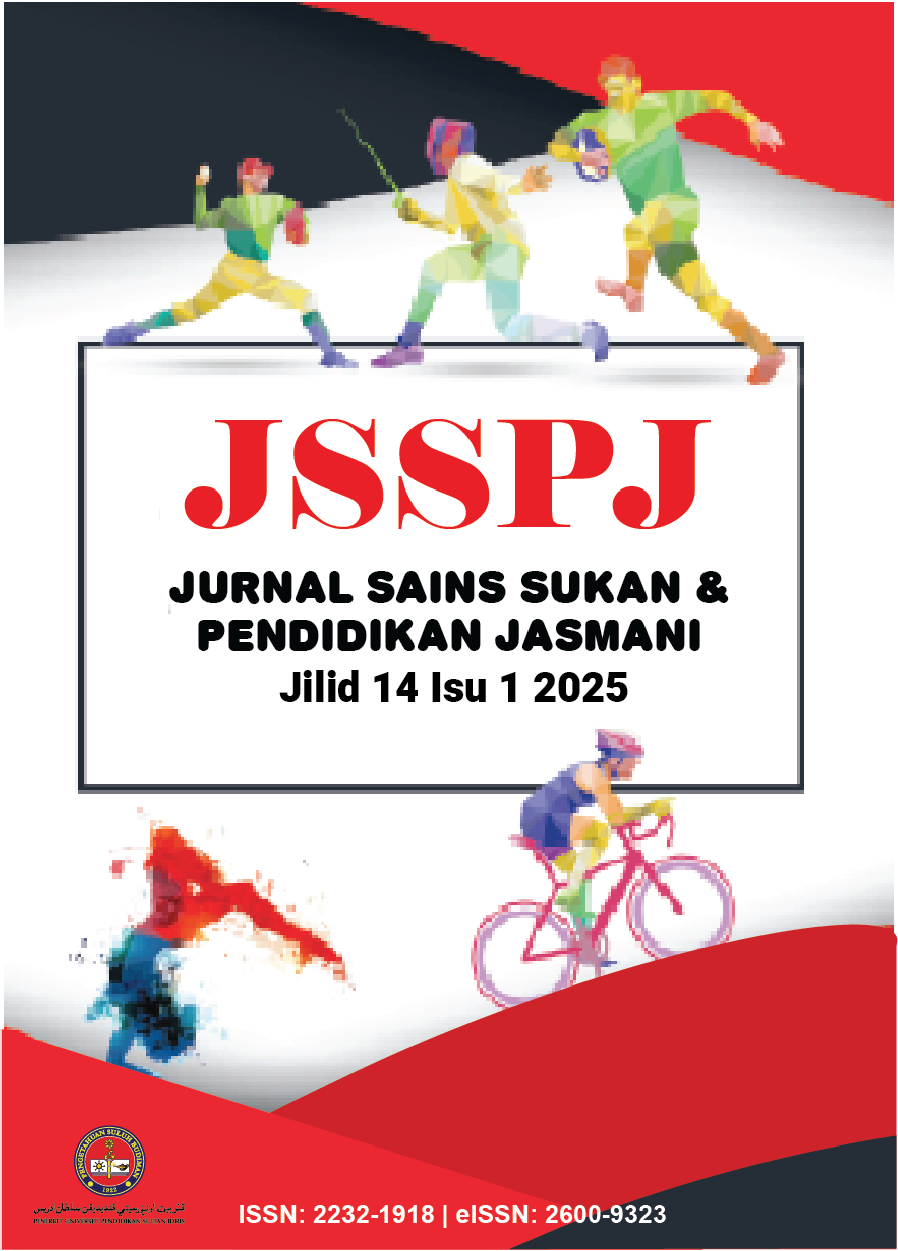Relationship between Body Composition and Fitness Performance among Malaysian Student-Athletes
DOI:
https://doi.org/10.37134/jsspj.vol14.1.5.2025Keywords:
Body Composition, Physical Fitness, Student-Athlete, Fitness Components, Sports PerformanceAbstract
This study investigates the relationship between body composition and fitness performance among student-athletes at Sultan Idris Education University, Malaysia. A cross-sectional correlational design was employed, involving 94 student-athletes (57 males and 37 females) from various sports disciplines. Body composition parameters including body fat percentage, muscle mass, and body mass index (BMI) were assessed alongside physical performance components such as speed (30-meter sprint), muscular strength (grip strength), balance (Stork test), agility (T-test), flexibility (Sit-and-Reach), explosive power (vertical jump), and cardiovascular endurance (VO₂ max). The results revealed significant relationships between body composition and performance metrics. Muscle mass was positively correlated with grip strength (r = 0.873, p < 0.01), vertical jump height (r = 0.599, p < 0.01), and agility (r = -0.584, p < 0.01), highlighting its importance in athletic performance. In contrast, body fat percentage was negatively associated with VO₂ max (r = -0.528, p < 0.01), explosive power (r = -0.703, p < 0.01), and sprint speed (r = 0.812, p < 0.01), indicating a detrimental effect on performance. These findings underscore the critical role of optimizing body composition, specifically by increasing muscle mass and reducing body fat, for improving athletic performance. The study offers valuable insights for coaches, trainers, and sports scientists in designing evidence-based training and nutritional interventions while also contributing to the limited body of research on university student-athletes in Malaysia.
Downloads
References
Akdoğan, E., Ayaz Kanat, E., Simsek, D., Bıdıl, S., Bayram, I., & Aktı, Y. (2022). Relationship between body composition, multiple repeated sprint ability and vertical jump performance in elite badminton players. International Journal of Morphology, 40, 720-727. https://doi.org/10.4067/S0717-95022022000300720
Bangsbo, J., Iaia, F. M., & Krustrup, P. (2008). The Yo-Yo intermittent recovery test : a useful tool for evaluation of physical performance in intermittent sports. Sports Med, 38(1), 37-51. https://doi.org/10.2165/00007256-200838010-00004
Cuenca-Garcia, M., Marin-Jimenez, N., Perez-Bey, A., Sánchez-Oliva, D., Camiletti-Moiron, D., Alvarez-Gallardo, I. C., Ortega, F. B., & Castro-Piñero, J. (2022). Reliability of field-based fitness tests in adults: a systematic review. Sports Med, 52(8), 1961-1979. https://doi.org/10.1007/s40279-021-01635-2
Fernandes-Da-Silva, J., Castagna, C., Teixeira, A. S., Carminatti, L. J., Francini, L., Póvoas, S. C. A., & Antonacci Guglielmo, L. G. (2021). Ecological and construct validity of a repeated sprint test in male youth soccer players. J Strength Cond Res, 35(7), 2000-2009. https://doi.org/10.1519/jsc.0000000000003047
Ferreira, G. O. C., Ferrari, G., Langer, R. D., Cossio-Bolaños, M., Gomez-Campos, R., Lázari, E., & Moraes, A. M. (2024). Phase angle and its determinants among adolescents: influence of body composition and physical fitness level. Scientific Reports, 14(1), 13697. https://doi.org/10.1038/s41598-024-62546-6
Grams, A. C., Acevedo, A. M., Price, P., Alvarez, K., Nowlen, M., Morton, R., Campa, E., & Zeigler, Z. S. (2023). Body Mass Index superior to body adiposity index in predicting adiposity in female collegiate athletes. Int J Exerc Sci, 16(4), 1487-1498. https://doi.org/10.70252/cjwq8241
Hammami, R., Makhlouf, I., Chtara, M., Padulo, J., & Chaouachi, A. (2015). The contribution of vertical explosive strength to sprint performance in children. Sport Sciences for Health, 11(1), 37-42. https://doi.org/10.1007/s11332-014-0200-2
Hernandez-Martinez, J., Perez-Carcamo, J., Coñapi-Union, B., Canales-Canales, S., Negron-Molina, M., Avila-Valencia, S., Cid-Calfucura, I., Herrera-Valenzuela, T., Cisterna, D., Branco, B. H. M., & Valdés-Badilla, P. (2024). Relationship between body composition and physical performance by sex in professional basketball players. Applied Sciences, 14(20), 9165. https://www.mdpi.com/2076-3417/14/20/9165
Hoffman, M., Schrader, J., Applegate, T., & Koceja, D. (1998). Unilateral postural control of the functionally dominant and nondominant extremities of healthy subjects. J Athl Train, 33(4), 319-322.
Jaremków, A., Markiewicz-Górka, I., Hajdusianek, W., Czerwińska, K., & Gać, P. (2024). The relationship between body composition and physical activity level in students of medical faculties. Journal of Clinical Medicine, 13(1), 50. https://www.mdpi.com/2077-0383/13/1/50
Kochman, M., Kasperek, W., Guzik, A., & Drużbicki, M. (2022). Body composition and physical fitness: does this relationship change in 4 years in young adults? Int J Environ Res Public Health, 19(3). https://doi.org/10.3390/ijerph19031579
Laursen, P. B., & Jenkins, D. G. (2002). The scientific basis for high-intensity interval training: optimising training programmes and maximising performance in highly trained endurance athletes. Sports Med, 32(1), 53-73. https://doi.org/10.2165/00007256-200232010-00003
Léger, L. A., Mercier, D., Gadoury, C., & Lambert, J. (1988). The multistage 20 metre shuttle run test for aerobic fitness. J Sports Sci, 6(2), 93-101. https://doi.org/10.1080/02640418808729800
McLester, C. N., Nickerson, B. S., Kliszczewicz, B. M., & McLester, J. R. (2020). Reliability and agreement of various inbody body composition analyzers as compared to dual-energy x-ray absorptiometry in healthy men and women. J Clin Densitom, 23(3), 443-450. https://doi.org/10.1016/j.jocd.2018.10.008
Oukheda, M., Bouaouda, K., Mohtadi, K., Lebrazi, H., Derouiche, A., Kettani, A., Saile, R., & Taki, H. (2023). Association between nutritional status, body composition, and fitness level of adolescents in physical education in Casablanca, Morocco. Frontiers in Nutrition, Volume 10 - 2023. https://doi.org/10.3389/fnut.2023.1268369
Redondo-Flórez, L., Ramos-Campo, D. J., & Clemente-Suárez, V. J. (2022). Relationship between physical fitness and academic performance in university students. Int J Environ Res Public Health, 19(22). https://doi.org/10.3390/ijerph192214750
Downloads
Published
Issue
Section
License
Copyright (c) 2025 Ebby Waqqash Mohamad Chan, Siti Musliha Mat-Rasid, Mohd Huzairi Mohd Sani, Thariq Khan Azizuddin Khan, Noorzaliza Osman, Rozaireen Muszali, Akimi Lotfi Aminudin

This work is licensed under a Creative Commons Attribution-NonCommercial-ShareAlike 4.0 International License.





